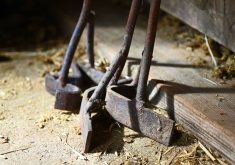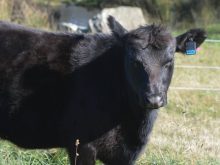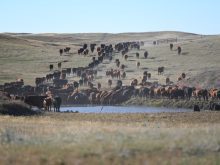The national livestock identification system has been around for a good while now, close to 25 years.
Through the system’s growing pains, lots of lessons have been learned and the system is being fine-tuned. Producers are deriving more and more benefit from using farm management systems linked to readers linked to scales, all based on the ability to read the radio frequency identification (RFID) tags. From lost animals, to identification at export, to transport, to traceability, a lot hinges on the tag being present so it can be easily read.
The purebred beef breeds are also using them somewhat for breed identification, in the sense that the different-coloured backs indicate a breed such as Angus (green backs) or Simmental (blue backs).
Read Also

Harvest wraps up and fall work begins
At the Eppich famly ranch in western Saskatchewan, the fall harvest was successful with few breakdowns, cows and calves have been sorted and a new tractor has arrived
Some breed organizations have given incentives to register early and receive tags — which are positive ways to ensure use.
The standard tags are still yellow and many of the different sire groups, as well as some of the purebred breeders, are sticking with straight yellow. Many purebred breeders raise two different purebred breeds, so have elected to stay yellow as well.
The bison industry has the white tags, and a marketing fee is attached to them, but it is really easy to see if a producer has put in the wrong tag.
All these options help with marketing or differentiation, and lately I have not seen one microchip fail.
Made to last
Emphasis is now being placed on retaining tags. Before 2020 about 18 per cent of tags were lost by about six years — which most beef cows get to. Dairy cattle on average would not get that old before being shipped. Breeding bulls are usually done by around five to six years on average, so we need to have tags we know are going to last for at least those six years.
From wear and tear, to ultraviolet light, to freezing and thawing in Canada, there is a lot the tag manufacturers are trying to compensate for — and they are doing it.
In tags, the industry leader, and current leader in market share, is Allflex. I know it has been working to strengthen the neck of the tags and a new tagger on the market (the white one) has replaced its green predecessor. It has slightly longer handles, gives more mechanical advantage and even fits smaller hands better. This makes it easier to tag and reduces fatigue if tagging many animals in a day.
If a pin is bent or broken it’s imperative that the same type of pin be used in the same brand of tag. They are all slightly different.
If there is ever a report of excessive tag loss, an investigation, involving either the tag manufacturer or the Canadian Cattle Identification Agency (CCIA), may follow. In every case I have heard of, the incorrect tagger or pin was used, application was in the wrong area or weather conditions were the potential culprit. Be careful when installing tags in extremely cold weather, as cold tags are not flexible enough.
One must try and put the tag in an area where it’s least likely to be caught or ripped out. An RFID tag should be put ideally a quarter of the way out from the head and in the middle, so the male back end is behind the ear and the thick radio frequency part is in the inside of the ear. This has been found to increase tag longevity. If placed in the top of the ear, the backing frequently gets caught.
I have seen many tags almost rubbed too thin by bulls; they are hard on tags, especially dangle tags, whether from fighting, rubbing, or throwing up dirt with their heads. This abuse gradually wears out the tag backing.
It will be interesting to see if ultraviolet light has any negative effect on some of the new coloured backs. Both the yellow and white tags have been good that way, so time will tell.
Robust systems
If we can keep the retainability creeping upward, tags may be incorporated with other devices that might measure temperature or ruminal movements and could detect disease earlier. Such tags are on the market, but not yet married to CCIA tags.
Even though the U.S. does not have a true national identification system, countries with lots of cattle, such as Brazil, are getting rather robust ones, so the world is changing.
It is great to see tags starting to give back valuable information to owners, and that the beef breeds see this as a valuable step in differentiating themselves. It is positive from world trade and food safety standpoints.
The changeover to ordering CCIA tags from the CCIA office or through the breed association has also gone rather seamlessly.
I encourage everyone to check out the CCIA website and learn the 10 guiding principles for tag application; some have been mentioned in this article.
There is also a user-friendly Canadian Livestock Tracking System (CLTS) mobile app where your password allows input and retrieval of your data. The technology is here; let’s use it.
I see RFID tags applied early in a calf’s life and I see good management, usually. Don’t buck progress, as it only makes lives easier, and traceable marketing improves.















